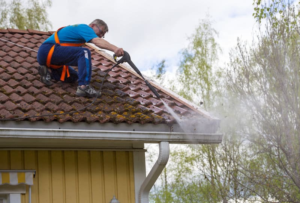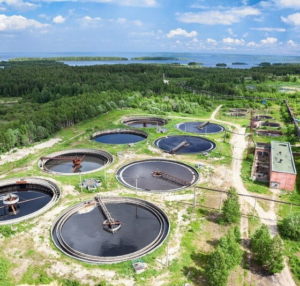Cleaner roofs protect the structure of your home or business from damage. It also reveals damaged areas that need to be repaired and prevents future water damage.
It can also help reduce energy bills, as moss and black streaks absorb heat. Roof cleaning also helps to keep pests away and extend the life of your roofing materials. Contact Sarasota Roof Cleaning now!

Dirt and grit can build up on your roof, scratching the protective layers of your shingles. This damage can cause the shingles to crack or deteriorate prematurely, leading to leaks and other problems. Regularly cleaning your roof removes these damaging materials and helps prolong the life of your shingles.
The first step in removing dirt and grit from your roof is to clean up any debris that has accumulated on the surface, such as leaves, twigs, or branches. You can use a leaf blower or gently sweep the debris off your roof with a broom, taking care not to damage your shingles. Next, rinse your roof with a garden hose or water hose, removing any loosened dirt and grime. You can also apply a biocide to the roof to inhibit future growth of moss, algae, and mold.
Depending on the type of stains you’re dealing with, you can scrub or apply a cleaner to your roof. For example, if you’re dealing with a buildup of grease stains, a degreaser such as Oxy Solve works well. If you’re trying to get rid of mold or mildew, a bleach solution such as Mold Armor Cleaner can be effective.
Before applying your cleaner, rinse the soffit and fascia of your home to ensure that they’re not affected by the cleaning chemicals. Also, make sure to cover or move any plants in the area that will be exposed to the cleaning solution.
Once your roof is clean, you can enjoy the view of a bright, stain-free surface and extend the lifespan of your shingles. You’ll also improve the look and value of your home and increase its curb appeal.
Your roof is one of the most important parts of your house, protecting you from rain, sun, and everything else that Mother Nature can throw at it. While advances in roofing technology have made asphalt shingles less prone to moss and algae growth, it’s still a good idea to clean your roof on a regular basis to prevent unsightly black streaks. You can do this easily and safely with a little pre-planning and the right tools.
Algae
Algae grows on shingles in cool, dark areas where there is not much direct sunlight. It can be removed with a standard household bleach and water spray. Avoid using a pressure washer, as excessive waterpower can degrade or shorten the life of your roof. A hose-end sprayer works best for applying the bleach solution to your roof. If you do use a sprayer, wet down any foundation plantings first to protect them from bleach overspray. After washing your roof, rinse it thoroughly to remove any remaining cleaner and dislodged algae.
You can also purchase commercially available algae-removal products at home improvement stores. If you choose this option, follow the product instructions for application and drying time. If possible, clean your roof in the summer when the sun is most bright. This allows the cleaning solution to dry quickly to avoid damage to your shingles.
After algae is removed, a quick rinsing with a garden hose will remove any remaining dirt and staining from your shingle roof. You can also scrub the roof with a soft-bristled brush or broom. However, this method is not recommended as it can scratch or loosen shingles. If you choose to scrub your shingle roof, do so gently and only in problem areas.
Depending on your roofing material, a mixture of trisodium phosphate (TSP) and bleach can also be used to lighten stains and kill remaining algae. However, it is important to test this mixture on a small area of your roof before using it for an entire surface.
The main cause of moss and algae on a roof is poor roof ventilation, overly porous roof materials, and the resulting dampness. Overhanging trees that drop debris onto the roof and clogged gutters also promote growth of these organisms.
You can spray a combination of equal parts standard chlorine bleach and water to sanitize and lighten moss or algae stains on a metal roof. If you decide to do this, make sure to use a low-pressure nozzle on your garden hose. You can also purchase zinc strips and apply them along the ridge of your roof to discourage future moss and algae growth.
Moss
Moss can damage a roof, especially if it gets too thick. It absorbs and holds moisture, which can cause rot and lead to roof leaks. It can also lift and tear shingles, leaving them vulnerable to further moisture damage. It’s best to clean moss as soon as you notice it, before it spreads too far.
To remove moss from a roof, start by brushing it off with a broom or scrub brush. You may need to use a longer-handled brush for difficult-to-reach areas of the roof. Be sure to wear rubber gloves and safety goggles as you brush. Next, wet the area where you want to remove moss with a garden hose. This will loosen the moss, making it easier to remove with a brush or your hands. If a large patch of moss is too ingrained in the shingles to remove with a brush, you can try using a putty knife. If you’re worried about damaging your roof, consult a professional before using a knife on the surface of your roof.
For a more permanent solution, consider using a moss killer. Many are available at home improvement stores in spray form or powder. Choose a cloudy day to apply the solution, as it will likely need to sit on the moss for 20 to 45 minutes or more. Liquid solutions can usually be rinsed off with a garden hose after the allotted time, but follow the instructions on the product’s label.
You can also use baking soda or vinegar to kill moss on your roof. Mixing baking soda and water can change the pH level of the moss, causing it to die. Vinegar, on the other hand, can be applied directly to mossy patches and killed with in just a few days. Again, be sure to wear rubber gloves and a mask when applying either baking soda or vinegar.
Be very careful when cleaning your roof, as you can damage it further with too much pressure or by using harsh chemicals. If you are uncomfortable navigating a ladder to reach your roof, or if you don’t have access to a moss-control product, it is best to call in the professionals. They’ll have the tools and experience necessary to safely and effectively remove moss from your roof, improving the overall look and integrity of your home.
Stains
Roof stains are more than just an eyesore. They can also affect your home’s value and resale potential. Luckily, there are multiple ways to remove these unsightly stains from your roof. Some methods require more time and effort than others, but they can still be well worth the investment if you want to increase your home’s curb appeal.
The most common roof stains are caused by gloeocapsa magma, which is the black algae that causes those ugly streaks on your roof. It thrives in warm, coastal climates, but it’s also a common problem for homeowners in the Midwest and other northern areas. It spreads via airborne spores and grows quickly in damp conditions. Once established, it can begin to damage shingle materials and shorten their lifespan.
Other stains can be the result of rust or other metal components like chimney flashing or a leaking chimney rain cap. These stains usually appear red in color, and are most common on homes with a masonry roof surface. Another common stain is white or light yellow in color, which is called efflorescence and can occur when wind-carried rain wets a masonry surface and then evaporates. The resulting mineral salts are left behind on the surface of the brick and leave those telltale streaks.
You can clean most stains on your roof using basic household products. Spray the soiled area with a 1:1 mixture of water and chlorine bleach, then rinse the solution from your roof using a garden hose or pressure washer. You can also use commercial roof cleaners that are available for sale online or at hardware stores. These typically contain chemical cleaners that can fight the growth of algae for a time, but they’re less effective than simply cleaning your roof regularly.
Ultimately, the best way to keep your roof looking its best is by maintaining regular maintenance and cleaning it regularly. In addition to improving your home’s curb appeal, cleaning your roof can extend its lifespan and help reduce the likelihood of costly repairs or replacement. So even if it’s not the most fun task, climbing up there for a day of hard work is far better than replacing your entire roof over an untreated problem.

